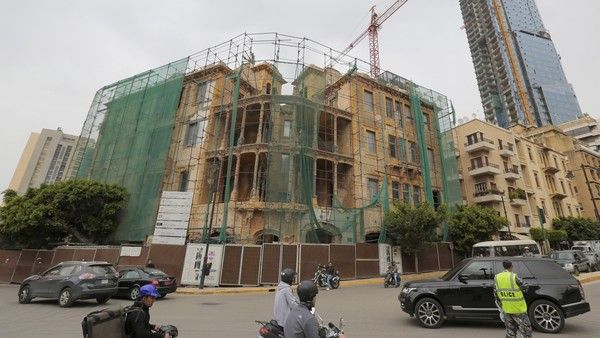
I must have passed the yellow house on Sodeco square a thousand times, giving no more than a fleeting thought to its ravaged façade. I figured it was another desolate building bearing the scars of the 1975-1990 civil war that no one had bothered to fix up.
While much of Beirut was beautified with renovations over the past two decades and some old buildings were torn down to make way for modern constructions, others had remained stuck in time
A few days ago, the yellow building took a whole new meaning for me. I sought it out, I searched it, and I discovered a Beirut that I had grown up in and forgotten. Although I only recently learnt of it, for the past few years, the inside of the yellow building, called Beit Beirut (the House of Beirut) has been a construction site for an unusual architectural goal: to maintain the memory of the war within it while also transforming it into a space where people can debate the history of the conflict.
Delving into the past is an ambition that, amazingly, few Lebanese have been interested in pursuing. It is one probable reason why, since the peace of 1990, the country has teetered many times on the brink of renewed conflict.
When the war ended, the surviving Lebanese militia erected their own martyrs’ monuments but no national memorial was ever built. Instead of reconciliation based on truth and accountability, the conflict stopped with an agreement redistributing power among Christians and Muslims, and an amnesty for most of the warlords. The past became a threat to what the Lebanese call, often unconvincingly, “national coexistence”.
“There was a general amnesty that led to a general amnesia,” says Youssef Haidar, the Beit Beirut architect who is due to finish the construction in two months, after seven years of work and many delays, partly due to political tension. “The Lebanese now have a selective memory and they reduce history to their own interests.”
The aim of Beit Beirut, he tells me, is to “work” on memory. “We want to get people to meet and to talk about the war so a process can begin.” Through Beit Beirut, other chapters of the city’s history will be told, with lectures and exhibitions. “It’s also about the memory of a city, on an architectural and urban level,” says Mr Haidar.
Beit Beirut has a unique history. The first two floors were built in 1924, after the collapse of the Ottoman Empire and the beginning of the French mandate. Two more floors were added in 1936, giving the building both post-Ottoman and art deco styles.
It was destined for more sinister use when the civil war erupted. Situated on the green line that divided the mostly Christian east and mostly Muslim west, it morphed into a snipers’ den, a “war machine” as Mr Haidar puts it. A decade after the war, pressure from civil society led the government to expropriate the building and work began to maintain it as a national memorial.
As we walk around, Mr Haidar says he has treated the building like a 90-year-old person, avoiding prettifying the wounds even while trying to heal them. The bullet holes remain in the walls, the bullet impacts preserved in size and direction; the staircase is a pile of rubble. A half circle modern structure was built and connected to Beit Beirut, giving access to the visible building and seven underground levels dug up to house archives, including the photo books of the families who lived there, and 50,000 negatives that tell the story of the city but were discarded by a photographer who rented space on the first floor.
The concrete installations of the snipers, the openings through which they fired, and the silhouettes painted on walls as camouflage for their enemies are still there too. “It will be a wounded body that will remind us of what happened,” says Mr Haidar.
Lebanon needs many Beit Beiruts at a time of amplified sectarian hatred and turmoil across the Middle East. I ask Mr Haidar whether once his work is completed the building will indeed serve as a catalyst for remembrance and debate. Having spent seven years on the project, he is optimistic. “There are a lot of expectations about this place and civil society is keen on it,” he says. “We are providing the tools for the process to start.”



